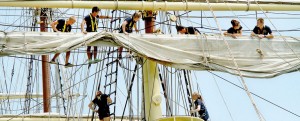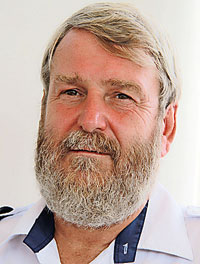News
Sailing the wind on a voyage of growing up
View(s):Sandun Jayawardana reports from the world’s oldest fully rigged ship in operation, which is also a school, when it called at the Colombo Port this week
Watching the sails of a ‘Tall Ship’ being unfurled is a thrilling sight. The operation takes endurance, speed, communication and, above all, teamwork. The sight of such sails being unfurled by teenagers is even more astonishing. Yet, this was what the Sunday Times saw when the media were invited onboard the Norwegian sailing vessel SS Sørlandet, the world’s oldest fully rigged ship in operation, which called at the Colombo Port this week while on its two-year circumnavigation of the globe.
As the vessel was berthed in port, only one of its 27 sails was unfurled by a teenaged crew, to provide a glimpse of how the most thrilling exercise onboard a tall ship is performed. Norway’s A+ Academy- an international high school has the unique distinction of owning a sailing ship, with a crew of 51 students who virtually, operate the entire ship.
When we visited the ship last Thursday, it was a hive of activity, with a group of students busy interacting with Sri Lankan Maritime Students who were onboard. Another group was busy polishing brass items and making the vessel ‘shipshape.’ “It’s all hands on deck today,” said Haakon (16), a student, noting that the ship was due to host a reception that evening for the Norwegian Ambassador and other dignitaries.
The ship began its circumnavigation in August last year from Kristiansand in Norway. One group of students took part in the first leg of the journey when it sailed from Norway to Hong Kong, and they were replaced by a new group who flew over. “We learned all the safety routines and fire drills before we left Hong Kong,” Haakon said. However, sailing the ship was something they learned on the job.
The journey has not exactly been “smooth sailing.” They had caught the tail-end of a typhoon on the way from Hong Kong to Vietnam, while the first few days of the journey from Christmas Island to Sri Lanka had also been marked by rough seas. Though the ship does have a motor, the objective is to use the ship’s sails as much as possible. Sails were used for 93% of the Norway-Hong Kong leg.

All hands on deck: Unfurling the sail. Pix by Indika Handuwala
Captain Odd Nordahl-Hansen who is in overall command, said he is “just a stand-in Captain” until another Captain takes over. “I’m running a museum, so I fit nicely in here,” he quips, referring to the vessel’s rich history.
Built in 1927, and nicknamed “The Pearl of Norway”, the Sørlandet has a long tradition of hosting students and cadets intent on a maritime education. Colombo is one of 44 ports and 22 countries she is visiting during her circumnavigation. The ship will be marking its 90th anniversary next year. The vessel is currently owned by the Sørlandet Foundation, which also operates the A+ Academy.
While the ship has a professional crew of around 10, they mostly supervise the students. “They (students) are the ones who actually sail the ship. We’re just teach them how to do it and ensure they do it well,” Captain Nordahl-Hansen observed.
The Sørlandet doubles as a floating high school, with most students spending their final year at sea, before going onto university next year. A group of Faculty members are also onboard to supervise the students’ studies. As A+ Academy is an international school, communication onboard ship, as well as lessons, are in English.
Students have regular classes from 9 am to 6 pm, while in between, they are rostered to be on deck-watch for two hours. Another two-hour watch is on at night, from 8 pm-8 am. The students’ living quarters are below deck. Space constrains on the ship means that, it serves as school, cafeteria and sleeping quarters. During the day, students have classes in this hall, as well as their meals. At night, they sleep in hammocks hung from hooks. The girls sleep on one side and boys on the other, separated by curtains.

Sophie

Captain Odd Nordahl-Hansen
The prospect of sending one’s teenaged son or daughter out to sea, to travel the world for 10 months in such a demanding environment, would concern any parent. “Yes, they were a bit scared, but they were actually rather jealous,” says Sophie (17). Haakon says his parents too were concerned, but were also very excited for him.
Nevertheless, the fact that the ship is also a school is never far from their minds. Haakon speaks about how busy life can be with all the homework in between watches on deck during the day and night. Seeing the writer’s incredulous look, he smiles and says, “Oh yes, lots of homework, but we like it.”
Another interesting facet is that, while at sea, the students have no mode of communication with the outside world.
“They take our phones,” says Sophie. They are returned once the ship reaches port and students are able to talk to families for a few days. Sophie insists that she is glad her phone is taken. “Back home, we spend so much time on social media. Now we’re learning to live without it.” Teachers though, do have email access and students’ parents can reach them if there is an emergency.
When in port, the school arranges field studies for students to learn more about the culture of the country they are in. In Sri Lanka, they conducted a field study on Buddhist temples in Kandy and also visited Sigiriya. “Free time” is exercised through shore leave, where students are allowed to go where they want. There are no “weekends” at sea. As such, shore leave is the only opportunity they get to relax properly.
“My nighttime watch is from 2 am to 4 am, so sleep can be a problem. I fall asleep on my homework all the time,” said Louise (17), when asked what’s the toughest part of her journey. While the students are mostly Norwegian, the teachers are mainly from Canada and the USA, due to the curriculum being an American one. Chadwick ‘Chad’ Hall from Canada is teaching Physics, Chemistry and Mathematics. Just as spending nearly a year at sea is tough on students, it is the same for teachers. “It does make for some very long days,” Chad acknowledges. However, he points out that most people get into the teaching profession because they want to work with youth, although this particular experience takes it to a whole new level. He had taken part in a similar expedition two years ago and had loved it, “So, I had to come back.”
When queried about the ‘stormy conditions’ the students faced, however, the man students call “Mr. Hall” offers a wry smile. “These guys haven’t seen stormy conditions yet. They think they have. There have been a couple of waves that came splashing up over the deck, but that’s not what you’d call stormy weather.”
As for rough weather, “We still have classes on those days. Keep that in mind. While all those waves are splashing out on deck, they’re doing Maths tests,” he adds.
Environment students find themselves in situations which forces them to develop many personal and leadership skills”, Chad further observes.
“You can’t avoid somebody, if you have a problem with them. There’s only 64 meters of space between you and them. So, you have to learn to grow up. You have to learn to handle things in a responsible way because, at the end of the day, you’re still going to have to work together. You’re still going to have to share the same watch. So, you have to find a way to grow up as a person, to overcome a lot of the issues that come up.”
The students are still only 2½ months into their 10-month stint at sea. Yet, one can observe that the experience has already had a profound effect on them.
“I already have a lot of stories to tell, and we still have 14 countries left,” exclaims Louise.
“It’s going to be the year they’ll talk about for the rest of their lives,” Chad chips in. “It really will be.”

